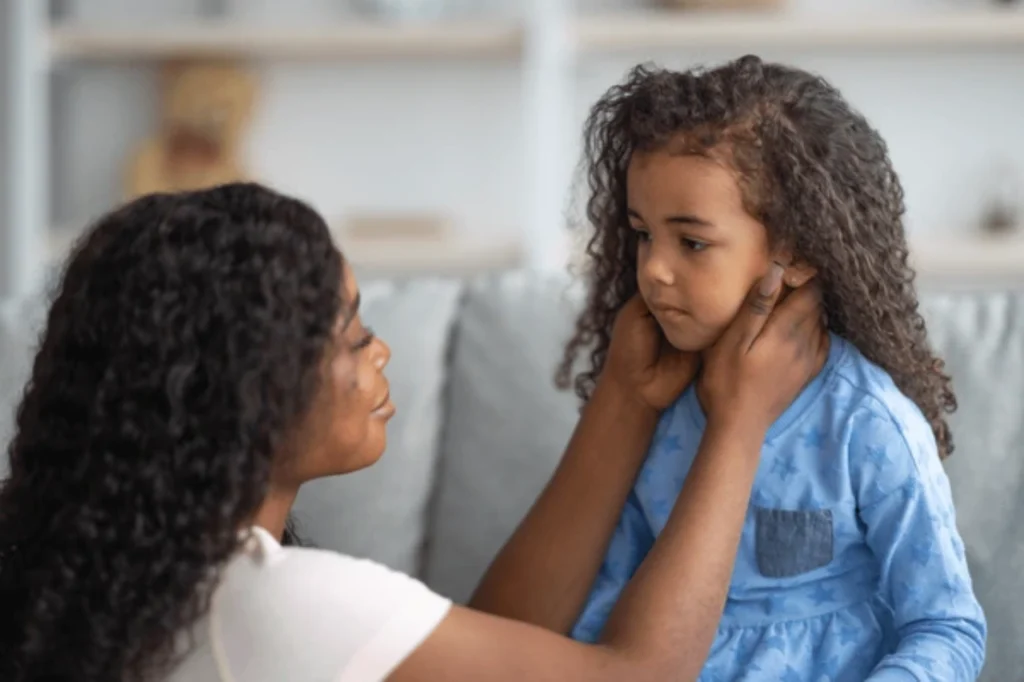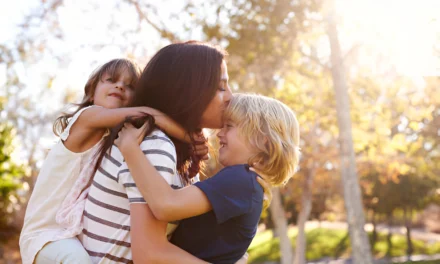Identify Emotions is key in a child’s growth, affecting their social life, school work, and happiness. As parents and caregivers, it’s vital to help kids understand their feelings early on. This guide will show you how to help kids grasp their emotions, making their relationships at home and school stronger.
Learn how to help kids spot their feelings, feel for others, and handle big emotions. This guide covers from babyhood to teen years, helping kids grow emotionally. Check out this useful resource and help your child deal with emotions confidently and strongly.
Key Takeaways
- Children who manage their emotions well are more likely to do well in school and get along with others1.
- Secure, trusting relationships with parents or caregivers are crucial for better emotion regulation in toddlers1.
- Positive interactions should outweigh negative reprimands to support children’s emotional development1.
- Collaboration among caregivers is essential for children struggling with emotion regulation1.
- Seeking guidance from professionals is recommended when a child’s emotional issues interfere with their well-being1.
The Foundations of Emotional Development in Children
Emotional development in children is complex and essential for their success. From birth, kids feel and show many emotions, like anger, sadness, and joy2. As they grow, they learn to handle more complex emotions based on their experiences and relationships.
The Role of Brain Development
The brain’s growth is key to a child’s emotional smarts. The right brain, especially the amygdala and limbic system, grows fast in the first 18 months3. This early growth helps kids start to understand and react to emotions, both their own and others’.
Why Emotional Intelligence Matters
Emotional intelligence is crucial for a child’s growth. The National Center for Safe and Supportive Learning Environments says it leads to important skills like self-awareness and managing emotions.2 These skills help kids do well in school and make good friends.
Children go through three emotional stages: noticing, expressing, and managing emotions2. Knowing these stages and supporting kids can help them develop emotional smarts.
Primary vs Secondary Emotions
From birth, kids show basic emotions like anger, joy, and fear3. As they get older, they feel more emotions. Secondary emotions are more complex and learned through experiences.
Understanding emotional development helps parents and caregivers support kids. Learning about emotional intelligence is key to a child’s future success.
Early Signs of Emotional Expression in Infants
Infants start showing emotions from the very beginning. By 2-3 months, they smile socially, showing joy and friendliness45. Around 4 months, they laugh on their own and show feelings like anger and sadness4.
As they grow, their emotional skills improve fast. By 5-6 months, they might feel scared of strangers. Around 4 months, they start to understand different emotions in others4. By 6 months, they start to copy the emotions they see4. By 9 months, they can frown to show they’re upset, and they have many ways to express feelings4.
- Infants begin showing a social smile around ages 2 to 3 months4.
- Infants begin to laugh spontaneously around age 4 months4.
- Between ages 2 and 6 months, infants express feelings such as anger, sadness, surprise, and fear4.
- Babies exhibit stranger anxiety between ages 5 and 6 months4.
- Around age 4 months, infants can begin distinguishing different emotional expressions of others4.
- Babies begin to mimic emotions and expressions they see in others around age 6 months4.
- Around age 9 months, babies first frown to show displeasure or sadness4.
- By nine months of age, babies have learned to express a wide variety of emotions4.
Infants learn to calm down, which helps them sleep better. Even when they’re not hungry or tired, they might fuss. This shows they’re uncomfortable, like when they whine or move a lot5. When we notice and respond to these signs, we show them we care. This helps them feel good about themselves5.
As they get closer to their first birthday, babies notice when others are upset. They might even feel jealous4. This growing awareness helps them learn to control their own feelings, starting around 11 months4.
| Emotional Milestone | Approximate Age |
|---|---|
| Social smile | 2-3 months |
| Spontaneous laughter | 4 months |
| Expressing a range of emotions | 2-6 months |
| Distinguishing emotional expressions | 4 months |
| Mimicking emotions and expressions | 6 months |
| Frowning to show displeasure | 9 months |
| Awareness of others’ emotional states | 12 months |
| Developing emotion regulation strategies | 11 months |
The early signs of emotional expression in infants show they’re learning about the world and their relationships. By noticing and responding to these cues, caregivers help these young learners grow emotionally56.
The Role of Parents in Helping Children Identify Emotions and Build Emotional Understanding

As a parent, you have a big impact on your child’s emotional growth. Research shows that being supportive and focusing on your child’s feelings can lead to good outcomes7. But being too strict or punishing can harm their social and mental health7.
Creating a Safe Emotional Environment
It’s key to create a safe space for your child’s feelings. Listen to them, validate their feelings, and be there for them. Studies highlight the importance of teaching children about emotions7.
Modeling Appropriate Emotional Responses
Children learn from what they see in their parents. If you show positive emotions, your child is more likely to manage their feelings well7. This helps them develop good ways to deal with emotions.
Building Trust and Connection
Being consistent and comforting builds strong bonds with your child. This is vital for their emotional health. Research shows that kids with good social/emotional skills behave better in school8. By trusting and connecting deeply with your child, you support their emotional growth.
Your role in shaping your child’s emotional understanding is vital. By creating a safe space, showing the right emotions, and building trust, you greatly influence their emotional development. Research stresses the role of parents in teaching social/emotional skills for success in school and life879.
Age-Appropriate Emotional Development Milestones
It’s important to follow a child’s emotional journey from birth to adolescence. By 2 months, kids can calm down when spoken to, look at faces, and smile when someone approaches. They also show happiness when they see familiar people10.
At 4 months, they start using smiles to get attention and laugh when they’re tickled. They also try to get or keep someone’s attention10.
By 6 months, most kids recognize people they know, enjoy looking in mirrors, and laugh. They start to show different emotions like happiness and sadness10.
At 9 months, children may feel shy or clingy around strangers. They also show various emotions like happiness and surprise. They react when called by their names and enjoy games like peek-a-boo10.
| Age | Emotional Milestones |
|---|---|
| 1 year | Capable of playing interactive games like pat-a-cake10 |
| 18 months | Move away but check if a caregiver is nearby, point out interesting objects, request assistance with tasks, engage in simple book reading, and cooperate during dressing routines10 |
| 2 years | Show empathy by recognizing distress in others, observe adult expressions for guidance in new situations10 |
| 30 months | Play alongside others and sometimes interact with peers, demonstrate achievements, and adhere to basic instructions like tidying up during playtime10 |
| 3 years | Settle within 10 minutes upon being left alone, demonstrate notice of other children and engage in social play10 |
| 4 years | Engage in imaginative play, seek companionship when others are not present, offer comfort to distressed individuals, avoid risky behaviors, enjoy helping, and adjust behavior based on different settings10 |
| 5 years | Follow rules and share during games, engage in creative activities like singing, dancing, acting, perform simple chores like matching socks, or setting the table after meals10 |
Children with developmental delays may face social challenges. This can lead to them feeling left out by their peers11. On the other hand, programs that help with social and emotional skills have helped over 50,000 people11.
As kids get older, they spend more time with friends and less with family. This shows they’re focusing more on peer relationships in high school11. Kids aged 9-11 tend to handle anger better, showing they’re getting more emotionally mature11. Toddlers, on the other hand, may show anger through aggressive actions like hitting or biting11.
Knowing these emotional milestones helps parents, teachers, and caregivers support kids. It ensures they’re emotionally well and have healthy social interactions.
Teaching Children to Recognize Different Emotions
Teaching kids to recognize emotions is key to their emotional growth. We give them the emotional vocabulary to understand many feelings. This helps them know themselves better and get along with others12.
Using Visual Aids and Stories
Visual tools like emotion cards or picture books are great for teaching kids. These resources help kids link facial expressions and body language to emotions. It makes it easier for them to know and say what they feel13.
Practice Activities and Games
Playing games like “Make a Face” helps kids practice recognizing emotions. These games let kids show different feelings. It helps them understand how emotions look12.
Emotional Vocabulary Building
It’s important for kids to have a big emotional vocabulary. This lets them talk about and handle their feelings well. We teach them words like “happy,” “sad,” “frustrated,” and “grateful”13.
By letting kids practice feeling and expressing emotions, we help them grow emotionally. This prepares them for success in social and emotional skills12.
Strategies for Managing Strong Emotions

Teaching kids to handle their strong feelings is key to their emotional growth. Parents can give them the tools to deal with intense emotions in a good way14.
One good method is situation selection. Kids learn to stay away from things that make them feel bad. Situation modification means changing the setting to make feelings less intense. For little ones, it’s about distracting them or finding a calm activity14.
As kids get older, they can use more advanced ways to control their feelings. Deep breathing exercises help them calm down and avoid big reactions15. Counting or doing physical stuff can also help older kids14.
Keeping a mood journal helps kids see their emotional patterns. This lets them handle their feelings better14. Mindfulness, like noticing feelings and surroundings, helps them know when to share their emotions14.
Handling emotions is hard when things are stressful14. Stress-busting activities like meditation and exercise help kids manage their feelings better15. If feelings are too much, getting help from a professional is a good idea14.
By teaching kids many ways to manage their feelings, parents help them deal with their inner world. This builds their strength to handle strong emotions in a healthy way.
The Connection Between Emotional Understanding and Social Skills
Emotional understanding is key in shaping a child’s social skills. Research shows emotional intelligence is linked to social skills in teens16. Kids who manage their emotions and understand others’ feelings do better in friendships and conflicts17.
Peer Relationships
Social skills are vital for good peer interactions and healthy friendships. Studies link strong social skills to less bullying16. Skills like empathy and communication help kids get along better with their friends17.
Empathy Development
Empathy is a big part of emotional intelligence. Kids with high empathy levels are less likely to be aggressive16. Teaching empathy through examples and role-playing helps kids build better social skills17.
Conflict Resolution Skills
Good conflict resolution skills are crucial for social success. Kids with strong social skills handle conflicts better16. Giving them chances to practice, like through role-play, helps them learn to solve problems17.
By focusing on emotional understanding and social skills, kids can improve their friendships, empathy, and conflict resolution. This prepares them for success in life161718.
Common Challenges in Emotional Development
Children face many challenges as they grow emotionally. One big one is not knowing how to express their feelings19. Teens might take risks as they explore and learn about boundaries19. They also might not understand facial cues or body language well, showing they are still learning about emotions19.
Another big challenge is managing strong feelings20. Kids with social emotional disorders might have mood swings and find it hard to control their emotions20. This can make it tough for them to make friends and feel good about themselves20.
Developmental issues can also play a big role in emotional challenges21. Conditions like ADHD, autism, and anxiety can affect how a child handles their emotions21. Stress early in life, like seeing or experiencing trauma, can make it hard for kids to calm down and handle their feelings21.
| Common Emotional Challenges | Potential Causes |
|---|---|
| Difficulty expressing emotions appropriately | Adolescent risk-taking, developing emotional intelligence |
| Managing strong emotions | Social emotional disorders, low self-esteem, poor social skills |
| Developmental issues | ADHD, autism, anxiety, early life stress |
Knowing about these challenges helps parents and caregivers support kids emotionally21. Teaching kids to manage their emotions can help them do better in school, make friends, and stay healthy mentally21.
Supporting Children Through Emotional Transitions
Life’s changes can be tough for kids. Starting a new school or family changes can make them feel anxious and unsure. It’s important for parents to help them cope with these big moments.
Life Changes and Adjustments
Up to 80% of kids feel anxious during big changes like starting a new school or moving22. Having regular routines can make them feel safer and more ready for changes22. Giving kids choices and control can also help them feel more independent and less resistant to change22.
Coping Mechanisms
Teaching kids how to cope with emotional changes is key. Using visual timers can help them understand time better, making transitions easier22. Keeping routines the same at home and school can also reduce their uncertainty and anxiety22. Showing them emotional support can boost their confidence and help them deal with changes22.
Parents can show kids how to handle stress by staying calm and solving problems together22. This can teach them valuable coping skills and build their resilience22. Celebrating their achievements can also make them feel more confident and positive about future changes22.
Helping kids through emotional transitions is tough, but with the right support, they can learn to handle life’s ups and downs.
The Impact of Environment on Emotional Growth
A child’s emotional environment is key to their growth. Emotional environment is the atmosphere, relationships, and experiences that help a child understand and manage their feelings. It’s vital to know how surroundings affect a child’s emotional development for their social-emotional skills.
Infants can tell the difference between happy, sad, and surprised faces early on23. By 6 to 7 months, they can spot the same emotion in different faces23. This shows how important a positive emotional environment is for child development from the start.
Urie Bronfenbrenner’s theory talks about five systems that affect children: microsystem, mesosystem, exosystem, macrosystem, and chronosystem24. The quality of care a child gets is crucial for their future24. For young ones, a safe place helps them form important bonds for their emotional and social growth24. It’s key to encourage caregivers to be responsive for healthy emotional development in kids24.
Children of depressed mothers struggle to tell apart happy and neutral faces23. Kids of anxious mothers look away from sad faces more than others23. Older kids who faced physical abuse find it hard to recognize emotions like happiness23. These examples show how a bad emotional environment can hurt a child’s emotional understanding.
By making a caring and responsive emotional environment, parents and caregivers help kids develop important skills. Knowing the big role environment plays in emotional growth is the first step to giving every child a great start in life.
Tools and Resources for Emotional Learning
Finding the right tools and resources for emotional learning is key for parents and teachers. Check out books that fit the age of your to help them understand and share their feelings. Books like “The Way I Feel” by Janan Cain and “F is for Feelings” by Goldie Millar are great for this25.
Digital tools and apps are also great for teaching emotional smarts. They help kids recognize, handle, and talk about their feelings25.
Books and Educational Materials
- Look for books that explore emotions, like “My Many Colored Days” by Dr. Seuss and “The Feelings Book” by Todd Parr.
- Find educational workbooks and kits that teach emotional skills through fun games and activities.
- Look for resources that tackle specific emotional issues, like anxiety or grief.
Digital Resources and Apps
There are many digital tools to help with emotional learning. These include interactive apps, educational websites, and virtual learning platforms. They offer lessons, activities, and feedback to boost emotional smarts25.
- Check out apps like “Smiling Mind,” “Breathe, Think, Do with Sesame,” and “Mood Meter” for mindfulness and emotional control.
- Explore websites and programs that teach social-emotional learning (SEL) for kids, parents, and teachers25.
- Use digital tools that give feedback and track progress to help kids improve their emotional skills25.
By using a mix of physical and digital resources, we can help kids grow emotionally. This supports their social-emotional development and well-being25.
When to Seek Professional Help
It’s important to know when a child needs help with their emotions. Emotional ups and downs are normal in kids. But, some signs might mean they need extra support26.
Signs a child might need help include big changes in their thoughts, feelings, or actions. These changes can make it hard to do everyday things like school or hanging out with friends26. They might feel worried, scared, or sad a lot. Or, they could get angry easily and feel overwhelmed by simple tasks26.
Other signs include worrying about hurting themselves, having trouble focusing, or thinking about alcohol or drugs too much26. Physical changes like not feeling well, sleeping a lot, eating differently, or using more drugs can also be red flags26.
Behavioral changes are also important to watch for. This includes not taking care of themselves, facing problems because of their mental health or drug use, or getting into legal trouble26. In kids, you might see them doing poorly in school, worrying too much, being very scared or clingy, having bad dreams, being too active, disobeying, being aggressive, or wanting too much comfort26.
Mental health issues are common, with2719% of U.S. adults meeting the criteria in 201927. More than half of people might get a mental health diagnosis at some point27. Getting help from a doctor, school counselor, or mental health expert can offer the support and help kids deal with these issues26.
Mental Health America has online tests for different problems, like drug misuse, depression, anxiety, postpartum depression, and children’s mental health. These tests can help figure out if it’s time to get professional help26.
Conclusion
As we wrap up this guide on helping kids understand their feelings, it’s key to remember that emotional growth never stops. Emotional understanding is a lifelong journey. By teaching kids how to handle their emotions, we help them grow strong, social, and smart28.
Every child is different, and that’s why it’s vital to tailor emotional learning to each one. By creating a safe space, showing them how to feel, and doing activities that fit their age, we help them grow emotionally and intellectually29.
Understanding emotions is complex, but we must keep learning and growing with our kids. By focusing on their emotional health and giving them the right tools, we prepare them to face life’s ups and downs. This way, they’ll grow up with empathy, resilience, and a strong connection to themselves and others28.
FAQ
What are the primary emotions that children experience?
How do infants express and regulate their emotions?
What is the role of parents in supporting a child’s emotional development?
What are the key emotional development milestones from infancy to adolescence?
How can parents teach children to recognize and name emotions?
What strategies can help children manage strong emotions?
How does emotional understanding impact a child’s social skills development?
What are some common challenges in children’s emotional development?
How can parents support children through emotional transitions and changes?
When should parents seek professional help for a child’s emotional challenges?
Source Links
- How to help kids understand and manage their emotions
- Understanding the Stages of Emotional Development in Children
- Developmental Stages of Social Emotional Development in Children – StatPearls
- Infancy Emotional/Social Development: Emotional Expression And Understanding
- Emotional & Social Development in Babies: Birth to 3 Months
- Infant Social & Emotional Development
- The Role Parents Play in Shaping Children’s Emotion Regulation
- The Role of the Family Context in the Development of Emotion Regulation
- Social-Emotional Milestones | earlystages
- Age-by-Age Social Development Checklist
- Teaching Feelings: Developing Emotional Intelligence in Kids
- How to Control Your Emotions: 10 Strategies to Try
- Emotion Management Strategies: 6 Methods to Try
- Relationship between Emotional Intelligence, Social Skills and Peer Harassment. A Study with High School Students
- What Are Social-Emotional Skills? | Child Development Skills
- Five areas of social and emotional learning – Be You
- Social and emotional changes: pre-teens and teenagers
- Understanding Social Emotional Disorders: Causes, Symptoms, and Treatment | Everyday Speech
- Emotional Regulation in Kids: Causes and Developmental Stages
- 8 Ways to Help Your Child with Transitions
- How the Emotional Environment Shapes the Emotional Life of the Child
- Promotion Social-Emotional Development: The Environment
- Resources on Social Emotional Learning (SEL) and Student and Educator Mental Health | NEA
- Signs of Needing Help
- 4 Signs It May Be Time To Seek Professional Mental Health Help
- Emotions Revealed | Conclusion | Reading Notes
- Conclusion / References





